|
https://selnd.com/2EZrrqL
Google featured snippets can now jump to section of content it is sourcing https://selnd.com/2RmYGdj 
Google can now link to some content it is showing in their search results in a new way. Instead of just linking to the page, Google can anchor you to the exact spot of the answer you are looking for and highlight the block of text that is most relevant to your query. This only works for some searches on Google mobile, that feature AMP content in the featured snippet block. How does it work? Go to mobile and search for something that returns both a featured snippet and is also an AMP page. For example, search on Google mobile for [what does a vpn do] and if you see a snippet from howtogeek.com and it has an AMP icon next to it, then you can see this in action. 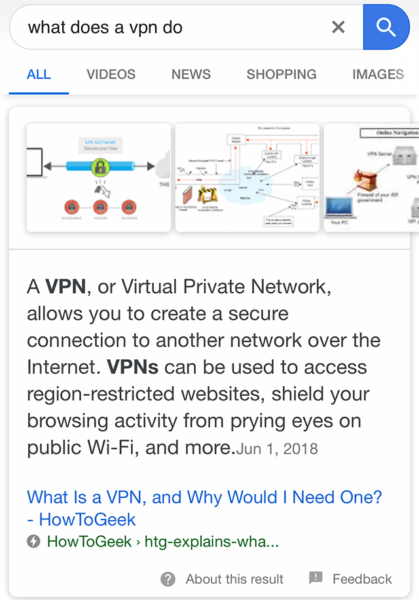
After you click on it, it anchors you to the section of content and highlights that content as well: 
Video. Here is a video screen capture of this in action: Why it matters. This is something webmasters and content producers should understand. If their content has an AMP version and a lot of your content shows up in the featured snippets section, then your visitors from Google may skip your header and be jumped to the middle portion of your page. This may impact ad clicks, it may impact conversion rates and other key metrics on your web site. So keep a close eye on your metrics, filter out your AMP mobile pages and try to see if moving elements around on your web page can result in a better conversion metric for these pages. About The AuthorBarry Schwartz is Search Engine Land's News Editor and owns RustyBrick, a NY based web consulting firm. He also runs Search Engine Roundtable, a popular search blog on SEM topics. SEO via Search Engine Land https://selnd.com/1BDlNnc December 31, 2018 at 09:17AM
0 Comments
https://selnd.com/2QaOUGF
What Amazon Advertising’s big 2018 advancements will mean for 2019 https://selnd.com/2QehcQq  It’s easy to over hype things, but 2018 will be remembered as a momentous year for Amazon’s advertising business. It is estimated to now be the third-largest ad seller in the U.S. behind Google and Facebook with 4% market share (keep the over-hype in check). What will fuel further advertiser investment are the kinds of product changes and developments we saw this year. Amazon still categorizes its ad business under an “other” line item in its earnings reports, but that segment topped $2 billion for the first time in Q1 and continued to see triple-digit growth year over year in the following quarters, reaching $2.945 billion in Q3. From our own Amazon Advertising Forecast 2019, based on a survey of more than 600 marketers, what stood out is the amount of runway ahead for Amazon advertising in terms of growing advertiser adoption, investment and development. Of the 80% of respondents who said they plan to increase Amazon advertising budgets next year, 60 percent expect to spend as much as 25% of their annual digital ad budget on Amazon. More than half plan to fund increased spend with incremental budget, 30% plan to shift budget from search, 24% said budgets will come from display or other non-digital budget lines such as print or TV and 21 percent said budgets will come from paid social. We asked several Amazon marketers for their thoughts on the biggest changes in 2018 and what they mean for advertisers and Amazon sellers in the year ahead. Unified branding and systemsIn September, Amazon retired its disparate ad product brands — Amazon Media Group (AMG) for managed display and video services, Amazon Marketing Services (AMS) for seller ads on Amazon and programmatic solution Amazon Advertising Platform (AAP) — and unified them under the umbrella Amazon Advertising brand. It also renamed Headline Search ads Sponsored Brand ads and the Amazon Advertising Platform is now Amazon DSP. The company also has plans to consolidate its platforms for sellers. As Recode first reported, Amazon is expected to launch One Vendor, a system that combines its Vendor Central (retail) and Seller Central (third-party marketplace), in the first half of next year. Earlier this year, Bloomberg reported that the company has merged its retail and marketing operations teams under Doug Herrington, SVP of Amazon’s North America consumer business. As evidence that Amazon made advertising a priority in 2018, Bryant Garvin, head of advertising at Pattern (formerly iServe), pointed to Amazon’s recent hires from Google, Twitter, Facebook and other major ad sellers and the roll out of more features that were once available only to Amazon’s retail division. Sponsored Brands, Garvin noted, were once available only in Vendor Central, and Sponsored Products gained added functionality such as category, brand and ASIN-level targeting. Interface and API saw big updatesAmazon’s campaign management capabilities still lag behind that of Google, but the company made many improvements this year. Todd Bowman, senior director of Amazon & eRetail at performance agency Merkle, said Amazon’s enhancements to the advertising UI and API were among the biggest changes the company made in 2018. In the UI, the changes made it easier to manage Search accounts on Amazon, said Bowman. These include updates to the reporting console, including the ability to filter and customize date ranges. More recently, Bowman pointed out, Amazon added Enhanced Budgeting control, which lets advertisers set portfolio budgets across campaigns. “By utilizing these portfolios to create a budget, advertisers now have a solution to set an overall budget across the account for a specific date range and essentially solve the issue of account level budget pacing,” said Bowman. The API upgrades, said Bowman, are “significant because integrators have been able to build tools that provide numerous opportunities for account management automation and bulk updating.” He cited three new capabilities, including bulk updates at multiple campaign levels; reporting parity between Seller Central and Vendor Central advertising programs with API support for Search Query and Purchase Product reports; and automated bidding via the API for Sponsored Product and Sponsored Brand ads. Merkle built and integrated its own internal bidding tool to manage client campaigns at scale. Sponsored Brands gained inventoryAmazon added more inventory for Sponsored Brands this fall. In addition to showing at the top of search results pages, the ad units can appear in the left-hand rail on desktop, below the fold on desktop and mobile and every thirteenth slot on mobile. This was also one of the most significant changes Amazon made this year, said Bowman. Sponsored Brands consistently deliver higher click-through rates than Sponsored Products or Product Display ads (which added video capabilities this year), said Bowman. “Because of the strong performance from these ads, adding additional placements on the [search results pages] for these ads is a big change that will benefit advertisers.” Bowman said that more impressions may cause CTRs to fall, “but the change will be an overall gain for brands as it will give them more opportunity to show an ad with multiple products and ad copy that can entice the customer.” Growing need for ‘hybrid’ approach to marketing on AmazonBrittany Page, associate director of SEO at 3Q Digital, said a number of elements put downward pressure on organic real estate, including the additional Sponsored Brands placements, expert recommendations, video-based buying guide and Amazon’s own private-label products, which are often flagged as “Top Rated from Our Brands”). Page expect organic real estate to continue to shrink, but said optimization and merchandising will remain critical. “Instituting a hybrid optimization approach of organic and paid campaigns will be the best strategy for brands looking to maximize their visibility,” advised Page. Garvin also highlighted the need for sellers to be thinking holistically when it comes to marketing on Amazon. “More so this year than any in the past,” said Garvin, “it isn’t simply enough for someone to create a good product and ‘list it’ with the right titles and descriptions to rank organically. It is truly requiring great products and content on the detail pages, strategically being amplified with advertising to drive the increase in DPV (detail page views) and sales that Amazon’s organic algorithm is taking into account.” Attribution and analytics advancements“With all that Amazon Advertising accomplished in their coming out year as a true enterprise-ready advertising channel, there is one standout agenda launched this year that will really change the game going into the coming years for large sellers and brand manufacturers advertising on the channel: Attribution and Stores Analytics,” said Nich Weinheimer, VP of e-commerce at advertising platform Kenshoo. Amazon Attribution is currently in beta. Amazon launched analytics for Stores in March, showing stats such as daily visits, page views, sales and sales units by page and traffic source. “As Amazon manages toward profitability and a ‘hands-off-the-wheel’ approach in ‘platforming out’ their solutions,” said Weinheimer, “exposing the customer purchase-path on Amazon via Attribution Beta and Stores Analytics marks an historic moment for the tech giant.” Having the ability to see what sources are driving traffic to Stores pages means brands can drive traffic from other channels and attribute sales back to those channels. “Brands without e-commerce D2C [direct-to-consumer] plays — think large CPG and consumer electronics suppliers — are now armed with the tools to leverage Amazon as their D2C play, able to expand advertising efforts from Facebook, other consideration channels or display media from outside Amazon to drive trackable performance on their largest e-commerce retail channel,” said Weinheimer. He predicts other online marketplaces to build out similar PPC advertising solutions for brands in 2019. “But Amazon is now arming its brand suppliers with the tools to pull even more traffic to its site from across the web, and the brands are happy to foot the bill.” Storefronts launched for SMBsFor smaller brands and sellers to showcase their wares, Amazon launched Storefronts in September. Tanya Zadoorian, senior marketplace channel analyst at CPC Strategy, also said the release of more sophisticated metrics for Storefronts and Stores this year were significant. “We’ve seen businesses leverage social media and Google text ads to drive traffic back to Amazon Storefronts to increase their visibility across channels,” said Zadoorian. This story first appeared on Marketing Land. For more on digital marketing, click here. About The AuthorGinny Marvin is Third Door Media's Editor-in-Chief, managing day-to-day editorial operations across all of our publications. Ginny writes about paid online marketing topics including paid search, paid social, display and retargeting for Search Engine Land, Marketing Land and MarTech Today. With more than 15 years of marketing experience, she has held both in-house and agency management positions. She can be found on Twitter as @ginnymarvin. SEO via Search Engine Land https://selnd.com/1BDlNnc December 31, 2018 at 09:01AM
http://bit.ly/2s3RQLC
9 Essential Local SEO & Listings Management Tools by @MaddyOsman http://bit.ly/2F0mmhE An online presence is important for both local and global businesses, especially those with physical locations. It may seem slightly counterintuitive for a local business to focus time on developing their online presence, until you realize that this is precisely where their customers are making buying decisions. Businesses that want to optimize for local SEO can make a big impact with the right focus, as well as the right tools. Listings management with these local SEO tools encompasses a wide range of features that include:
Some tools on this list narrowly focus on one of these features (such as ReviewTrackers, which specializes in review management), while others offer an all-in-one solution. Some of the best SEO tools on the market, such as Moz and SEMrush, have adapted their all-in-one SEO tools to include listings management as an optional add-on feature. Ultimately, the tool(s) you pick for local SEO are a function of your unique needs. The following represent the best options for each aforementioned listings management feature – as well as several all-in-one local SEO solutions. Local SEO & Listings Management Tools1. Whitespark 
Whitespark got its start as a web design agency, but now also offers SEO software tools that help businesses with local search marketing. The Citation Finder tool is Whitespark’s most popular offering. It helps you find the citation opportunities you’re missing so that you can improve relevant local search rankings. The tool is free to use for 3 searches/day and limited search results — perfect for those who are still exploring the tool. As of the publication of this ebook, paid subscriptions start at $17/month for 20 searches/day and unlimited search results. Other notable Whitespark local SEO tools include:
2. Yext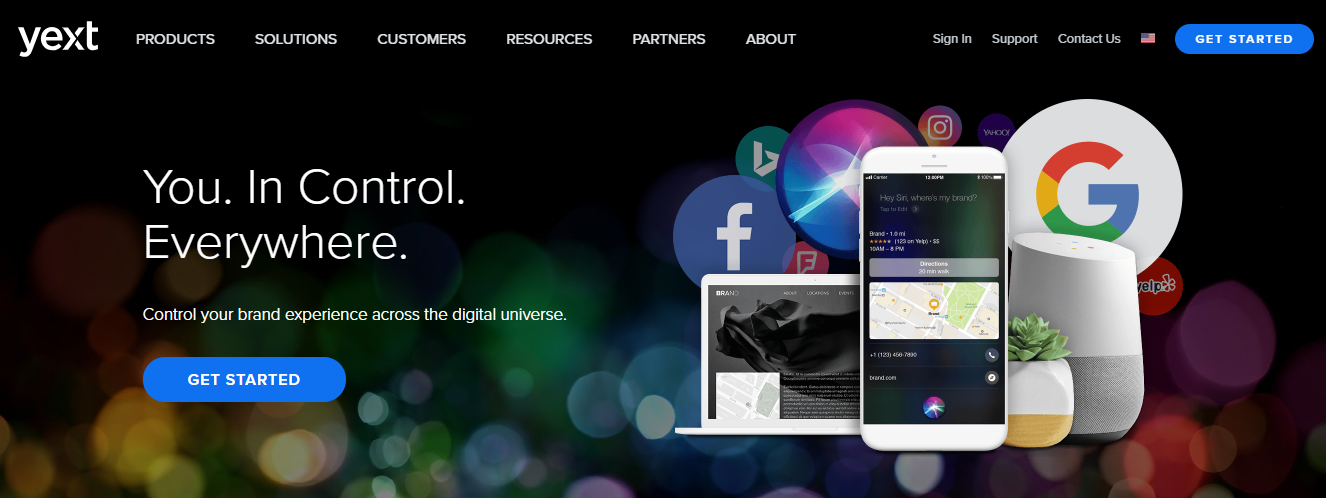 
Yext provides a variety of products and solutions that can help your brand improve local SEO. Yext integrates with hundreds of directories to ensure that your business information and data are always up-to-date. Some of Yext’s most popular local SEO tools include:
Additionally, Yext’s services and solutions include:
3. ReviewTrackersReviewTrackers is a customer review software tool that sends alerts regarding customer feedback on various review websites, making this information available in one useful dashboard. Using ReviewTrackers, you can solicit feedback from customers, monitor reviews from various sources (e.g., Google, TripAdvisor), and track location performance. ReviewTrackers is used by brands like Subaru, Midas, and American Family Insurance. At the time of publication, single location plans start at $59/month, while multi-location plans start anywhere from $10-$50/month per location. 4. Moz Local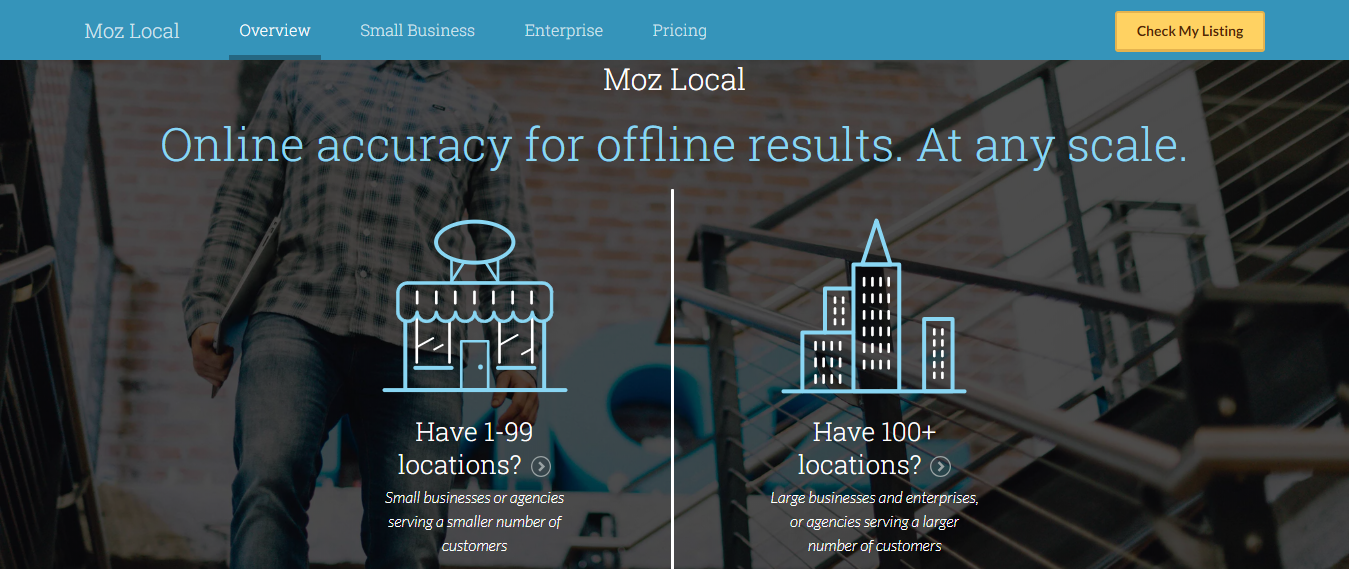 
Moz Local is perhaps the most popular local SEO tool on this list. After being in business for over 10 years and trailblazing the SEO software market, you can trust in both their data and methodologies. Moz Local works for both small and enterprise businesses, ensuring that online listings are correct and consistent, which helps to boost website visibility. Using this tool, you need only put together a listing once – Moz automates the rest of the process for you. Moz works by sending your listings data to major search engines, apps, directories and business aggregators. The beautiful thing about this process is that if you ever need to edit your listing, it’s as simple as logging back into Moz Local to make a change – there’s no need to edit your listing on each directory individually. Using Moz Local, you’ll receive alerts when you receive new reviews on major platforms so that you’re empowered to reply to your customers in a timely manner. Moz Local syncs with Google My Business and allows you to directly respond to Google reviews. Apart from the features that help boost your brand name in local search, Moz also gives you location-centric reports to help you track your growth and determine key consumer interactions on your listings. At the time of publication, pricing for Moz Local starts at $99/year — just note that this pricing doesn’t include access to their other popular SEO software tools. 5. Synup 
Synup is an all-in-one marketing software suite specifically tailored to help with local SEO. This all-in-one solution allows you to manage your listings, monitor your analytics, and create reports. Specifically, Synup facilitates unlimited listings updates and notifies you immediately when new reviews have been created about your business. Synup crawls over 200 local search engines and directories to catch inconsistencies. At the time of publication, Synup costs $30 per location for the first 25 locations, with pricing scaling down as you add on more locations. 6. Local SEO Checklist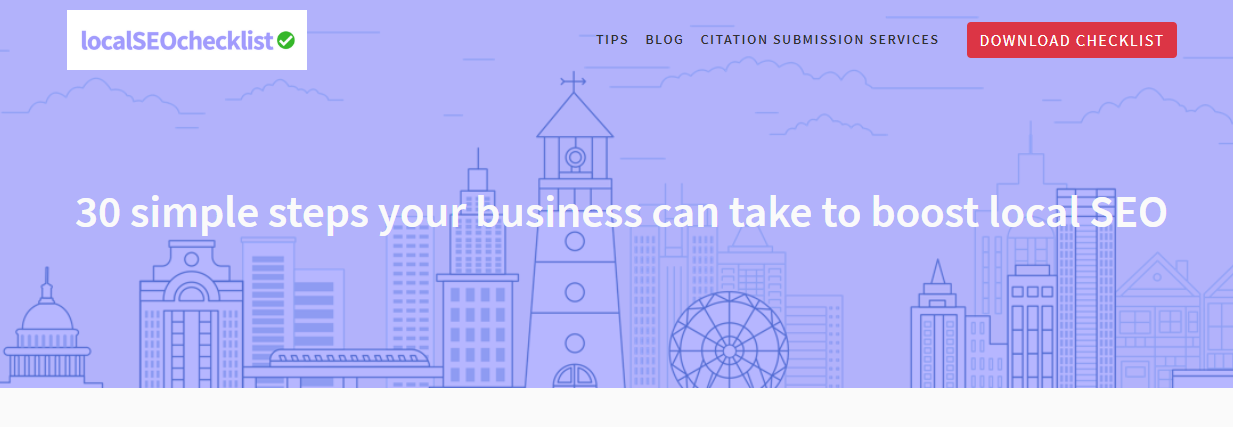 
Unfortunately, none of these tools can fix glaring technical local SEO issues on your website, which is where Local SEO Checklist comes in. Powered by Synup, the free Local SEO Checklist details the various ways you can optimize your website for local search. Aside from the checklist, you can also use this website to:
Search Engine Journal also offers a local SEO checklist for you to follow along with. 7. SEMrush 
Favored by brands such as eBay, HP, and Quora, SEMrush is a popular SEO and search analytics software tool. SEMrush provides users with website traffic information, keyword information (most ideal for paid search needs) and other SEO data that includes useful competitor information. Perhaps SEMrush’s most popular tools include their keyword research tool, backlink checker, and competitor analysis. SEMrush recently introduced their own listings management tool, launched in collaboration with Yext, which is currently in beta testing as of this publication. Based on initial perceptions, it seems quite easy to use. You have to first input the data and find your location. The tool will present a list of your listings and their status for each directory website. After you make any necessary edits, SEMrush will take care of the rest – automatically updating your listings accordingly. To sign up for this new SEMrush feature, you’ll need an SEMrush plan (which starts at $99.95/month), then add $20/month per location. 8. BrightLocal 
BrightLocal is one of the most popular local SEO tools, used by more than 62,000 agencies, businesses, and freelancers for analytics and reporting functions. Top features of Bright Local include:
At the time of publication, prices start at $29/month for a single business. 9. Advice Local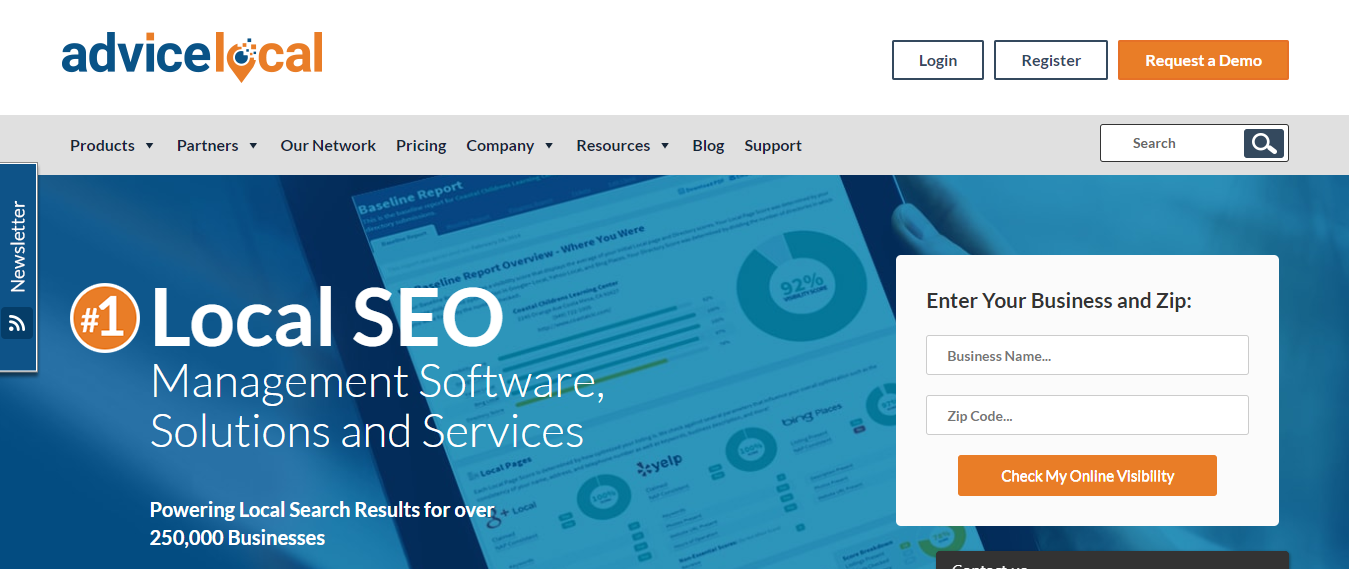 
Advice Local is another listings management tool that can compete with the likes of Yext for the most number of directories supported. That said, Advice Local’s advantage over Yext is that you can manually build out local citations while Yext uses an API. However, because of this, it takes a bit longer for Advice Local to get above an 80 percent score for local directory submissions and the information supported is limited to the basics of NAP (name, address, phone number). Additionally, like Moz, Advice Local is a complete all-in-one local SEO solution (unlike Yext, which is more directory-focused). At the time of publication, plans start at $15/month. Image Credits Featured Image: Paulo Bobita SEO via Search Engine Journal http://bit.ly/1QNKwvh December 31, 2018 at 08:04AM
http://bit.ly/2EZF3SP
How to Completely Optimize Your Google My Business Listing by @searchmastergen http://bit.ly/2TiqhJR To achieve digital marketing success by leveraging a location-based strategy, most seasoned SEO professionals start at the same place: creating a Google My Business listing. And for good reason. Google My Business (GMB) – the free tool from Google that helps business owners manage their online presence across the search engine and its growing portfolio of utilities – offers the greatest impact for brands seeking local exposure. Features like Google’s Local Search results (shown in the screenshot below), which break out with a list of nearby businesses and much of the pertinent information needed to find a specific business (e.g., address, business hours, category, reviews) and potentially buy something, further emphasize the need for a GMB listing for both new and established businesses. 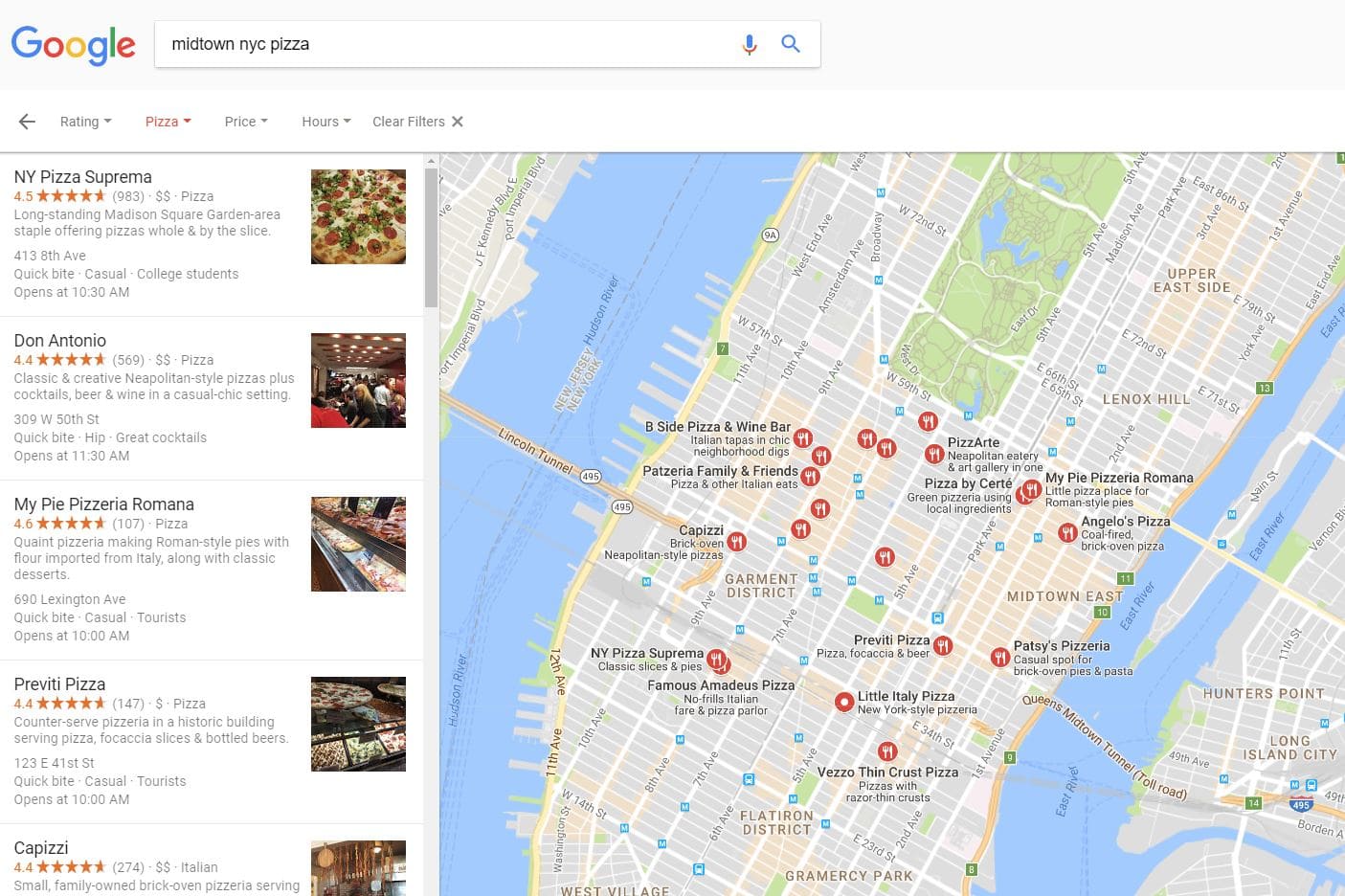 
Google’s Knowledge Graph also utilizes verified Google My Business information to help generate details for its database about businesses and related entities that are relevant to specific searches. Once a new listing is created, a Google Maps location is then generated that synchronizes with traditional Google Search for easy access and searchability. It certainly helps that the clear majority of organic searches come from Google (around 90 percent for worldwide search engine market share), further illustrating the value of a GMB listing. Use this guide to ensure you’ve completed your Google My Business listing correctly, and optimized all possible facets of the tool to get the most leverage for your business on Google and third-party platforms that use the Google Maps API to generate location information for users. Basics of Google My BusinessIf digital marketing is a somewhat new endeavor for you and your business, there are some basics to recognize to ensure you fully understand Google My Business and the value it offers. First off: yes, using Google My Business is free. And, no, a GMB listing doesn’t replace your business’s website. Google My Business complements your existing website by giving your business a public identity and presence with a listing on Google, the most popular search engine in the world. The information you provide about your business can appear in Google Search, Google Maps, and on Google+. If you’ve previously used certain Google tools to complement your business, or your business has been operating for a while, chances are your business is already listed on Google My Business. Google Places for Business and the Google+ Pages Dashboard were the best ways to manage your business information previously, but both have automatically upgraded to Google’s universal platform, Google My Business. Starting Your Google My Business ListingFirst step to getting your Google My Business listing up and running is to actually conduct a Google search to ensure your business doesn’t already have a GMB listing. If your business has been around for a while (several years or more), it’s likely it already has a GMB listing and you just need to claim it. Once successfully claimed, you can manage the information just as if you started the GMB listing yourself years previous. Head over to the Google My Business page for adding and claiming GMB listings and enter your most important business information (business name and address) to ensure your business doesn’t already have a listing that you need to claim. If there is already a listing for your business, it will notify you. It may also notify you that someone else already claimed your business. If that happens, follow these steps.  
Fill out the remaining input boxes with your business details, ensuring everything is accurate and grammatically correct (capitalize your business name, street names, etc.). Be sure to find the best relevant category for your business (there are a lot of variations to choose from). The last option listed asks if the business being created delivers goods or services to customers at their location. This is valuable for many businesses that operate away from their brick-and-mortar headquarters and, typically, at the home or business of the customer (cleaning services, construction companies, pest control, other home services, etc.). Add or Edit Service-Area Business DetailsTo add or change your service area details: Sign in to Google My Business and make sure you’re using “card view.” If you’re viewing your locations as a list instead of cards, switch to card view by clicking the cards icon on the right side above your locations.
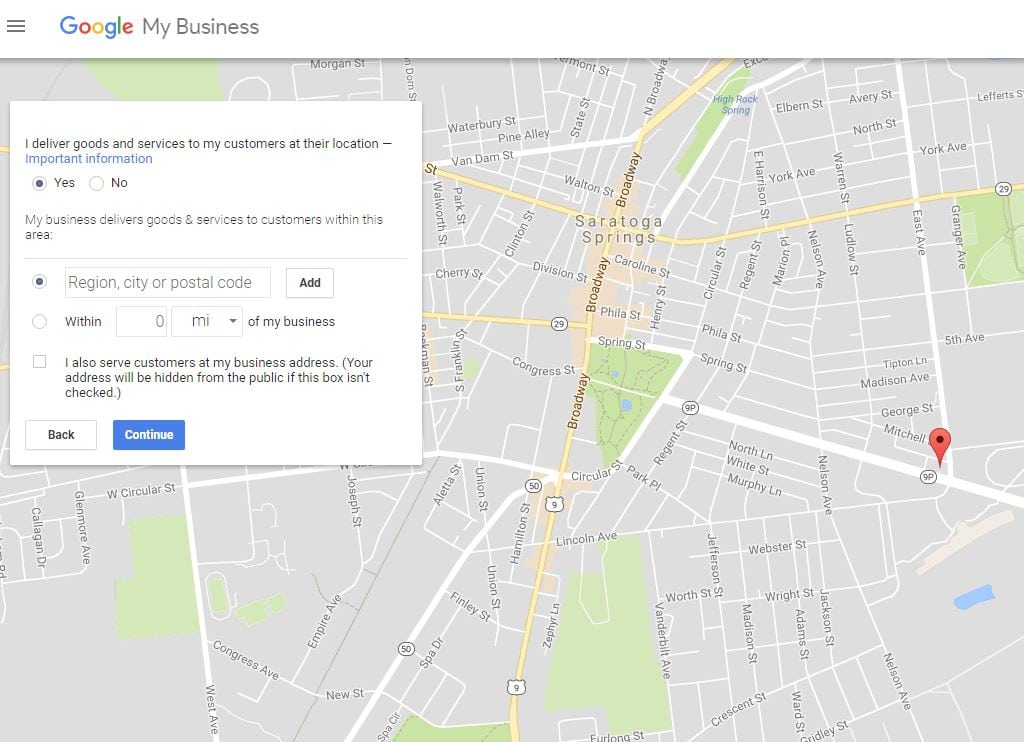 
Verifying Your Google My Business ListingOnce you have submitted your business info and your service area (if applicable), you’ll need to verify your listing. This is crucial for the visibility and performance of your business listing. It’s probably easiest to verify your listing by mail. By doing so, Google knows the address you’ve provided as a business address exists and you receive mail there. This helps Google weed out the false listings that will only misdirect users and derail the usefulness of Google Search and Maps, among other tools. It’s important to recognize that Google won’t display your business or its edits until the business is verified. You also can’t access any page insights/analytical information or business reviews. Verification typically takes less than a week, in which Google will send you a verification code postcard that, once you receive, you verify with the enclosed code and your business will officially be live. Publishing Your Google My Business ListingIt’s important to use all resources Google My Business offers within its listing details to get the most out of your business locations. Some basic but crucial tips for optimizing your listing: Enter Complete Data for Your ListingLocal search results favor the most relevant results for searches, and business offering the most detailed and accurate information will be easier to serve in search. Don’t leave anything to be guessed or assumed; make sure your listing communicates with potential customers what your business does, where it is, and how they can acquire the good and/or services your business is offering. Include KeywordsJust like traditional website SEO, Google uses a variety of signals to serve search results, and including important keywords and search phrases to your business listing will be incredibly helpful, especially since your business website is listed directly within your GMB listing. Keep Business Operating Hours AccurateIt’s important to enter your business hours, but equally important to update them whenever they change. Google offers the ability to customize hours for holidays and other special events, and it should always be used to keep your site accurate and users happy. Add PhotosPhotos help business listings’ performance more than most business owners and marketers probably expect. Businesses with photos on their listings receive 42 percent more requests for driving directions on Google Maps and 35 percent more click-throughs to their websites than businesses that without photos, according to Google. (Keep reading for more GMB photo tips.) Manage & Respond to Customer ReviewsInteracting with customers by responding to their reviews illustrates that your business values its customers and the feedback that they leave regarding it. Positive reviews are going to have a positive effect on potential customers when researching your business, but they also increase your business’s visibility in search results. Encourage customers to leave feedback by creating a link they can click to write reviews for your business. Photos for Your Google My Business ListingThe most important piece of imagery in your GMB listing is obviously your profile photo. There likely won’t be an image that gets more exposure, and there likely isn’t one that will have more of an impact either. Your business profile photo should not be the brand logo itself, but of something appealing and encompassing of the brand, what it stands for, and/or what it offers. Other types of images that should be added to your GMB listing are:
All photos should follow Google best practices:
Monitoring Your Google My Business Listing InsightsOver the last several years, Google has made tremendous strides with available analytical data for Google My Business listings. Now called Insights, Google offers businesses a different way to understand how customers interact with business listings, including:
How Customers Find Your ListingThis section of Insights shows how customers found you in a “Direct” search (they searched for your business name or address) versus a “Discovery” search (they searched for a category, product, or service that you offer, and your listing appeared). These sections have the following labels in bulk insights reports:
Where Customers Find You on GoogleThis section shows how many customers found you via Google Search or Google Maps. Beside “Listing on Search” and “Listing on Maps,” you’ll see the number of views your listing received from each product in the timeframe you’ve selected. According to Google, “Views” are like “impressions” on other analytics platforms. To see how many people found you on a particular product on a particular day, place your cursor over the appropriate segment of the graph on the day you’re interested in. These sections have the following labels in bulk insights reports:
Customer ActionsThis section shows what customers did once they found your listing on Google. “Total actions” gives the total of the following types of actions that customers took on your listing:
The following labels are available as reports in this reporting section:
Direction RequestsThis part of Insights uses a map to show where people are that are requesting directions to your business. Your business location is identified on the map and some of the most common spots that people request directions to your business from are shown. It even breaks the total number of direction requests down by city or neighborhood. Phone CallsThis section shows when and how often customers called your business via your listing on Google. At the top of the section, “Total calls” gives the total number of phone calls for the selected time frame. The graph offers the ability to view trends by phone calls by either day of the week or time of day. This lets marketers and business operators know when customers are most likely to call after seeing your GMB listing. PhotosLastly, GMB allows you to examine how often your business’s photos are being viewed with the “Photo views” graph and “Photo quantity” graph. There are also lines on the graphs that compare your business’s photo data with photo data for other businesses similar to yours. Section of this reporting component includes bulk insights for:
Image Credits Featured Image: Paulo Bobita SEO via Search Engine Journal http://bit.ly/1QNKwvh December 31, 2018 at 07:48AM Google Moving Google Posts Back Up? http://bit.ly/2GLvqss
drastically dropping off
Amy Toman posted on Twitter several screen shots of Google testing showing the Google Posts back in the original top position. Personally, I tried to replicate this on all of these examples and they all show at the bottom position of the local panel for me. But maybe, Google is doing a limited test to bring the Google Posts back up to the top of the local panel again. Here is one screen shot from Amy:
Again, when I tried this one, it only showed up at the bottom of the local panel for me.
SEO via Search Engine Roundtable http://bit.ly/1sYxUD0 December 31, 2018 at 07:37AM
http://bit.ly/2EZtBqe
NBA All Star Voting On Google http://bit.ly/2SpgFgt
Did you know you can go to Google and vote for your favorite NBA players for the All Star game and events. It works on Google.com, Google Assistant or on the NBA web site or apps. Go to Google and search for [nba all stars] or any team name or NBA related query and you'll see it. NBA.com has the press release on this news from several days ago. Here is how to vote on Google:
Here is what it looks like in search:
The "sponsored" label at the top reads: Google has partnered with the NBA to be an official voting method for NBA All-Star Voting 2019. Forum discussion at Twitter. SEO via Search Engine Roundtable http://bit.ly/1sYxUD0 December 31, 2018 at 07:22AM Google AMP Featured Snippets Anchor & Highlight Content http://bit.ly/2SujcpA
9to5Google found a new Google feature that works on mobile for some featured snippets that lead to AMP pages. If you click on an AMP based featured snippet in mobile search, Google may jump you down, anchor or scroll you down, to the specific section of content in the featured snippet and also highlight the content. I was able to replicate it for several queries - you can try it yourself, it works on many featured snippets that show the AMP version of the page. Step one, find content in Google search on mobile that is a featured snippet that also is an AMP URL:
Step two, click on it and it will scroll you down to the specific part and highlight it:
There is even a link to "Go to top" if you don't want to be scrolled down. Forum discussion at Twitter. SEO via Search Engine Roundtable http://bit.ly/1sYxUD0 December 31, 2018 at 07:03AM
http://bit.ly/2CGfG6a
Unicode Works Within Google Local Listings http://bit.ly/2EWBQTa
Andy Simpson spotted a local panel that was using unicode to make the business name stand out from the rest. Andy was doing a normal search for a barber shop and this listing came up in Google's local results, which caught his eye. You can see it yourself by searching for [nathan's tonsorial parlor. Here is a screen shot:
On the search side, Google tends to drop out of ignore special characters from showing like this in search. It is not a new thing, it goes back before come back. I am not sure if this unicode in the Google local listings will stick but we will see. Forum discussion at Local Search Forums and Twitter. SEO via Search Engine Roundtable http://bit.ly/1sYxUD0 December 31, 2018 at 06:47AM New Year's Eve 2018 Logos & Themes From Google, Bing, Yahoo & Baidu http://bit.ly/2EVLjet
2019 is around the corner and to celebrate, Google, Bing, Yahoo, Baidu and others in the search industry have special logos and home page themes. Here are screen captures from these sites for the 2018 New Year's Eve event. Google's New Year's Eve 2018:
Yahoo's New Year's Eve 2018:
Bing's New Year's Eve 2018:
Baidu's New Year's Eve 2018:
Everyone have a safe, healthy, fun and enjoyable New Year's Eve! Forum discussion at Twitter. SEO via Search Engine Roundtable http://bit.ly/1sYxUD0 December 31, 2018 at 06:34AM
http://bit.ly/2GMwe0d
Google Log Cabin Room http://bit.ly/2SumOrJ
Here is a room at one of the Google offices that looks like it is part of a log cabin. You got the wood walls and ceilings, the brown furniture, the interesting mantel and fireplace with stone. This was posted on Instagram. This post is part of our daily Search Photo of the Day column, where we find fun and interesting photos related to the search industry and share them with our readers. SEO via Search Engine Roundtable http://bit.ly/1sYxUD0 December 31, 2018 at 06:25AM |
Categories
All
Archives
November 2020
|
















 RSS Feed
RSS Feed
